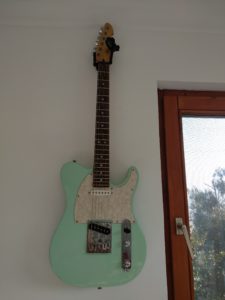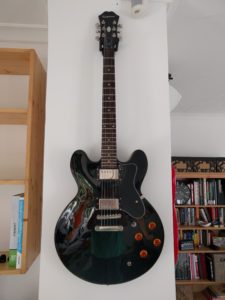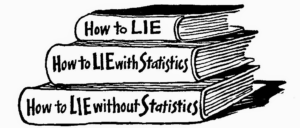Another guest post, this time by my friend, colleague and trusted teaching assistant for Scopes and Methods: Stanislas Richard.
Procrastination is not a new phenomenon – Leonardo Da Vinci is famous for having left unfinished a fair number of his paintings. However, his procrastination was not entirely a problem neither for him nor his creativity. If Leonardo decided to postpone the completion of the Adoration of the Magi and to work on The Last Supper instead, it is more likely he did so because he felt the final work would not meet his expectation (perfectionism is often the main cause of procrastinating behaviour), rather than him just being lazy. Neither Andrea del Verrocchio, Leonardo’s early master, nor Ludovico Sforza, his first unfortunate patron, could complain that his procrastination was unproductive.
Delaying the completion of a task was not a problem for the Renaissance man’s career, and this, in a nutshell, is the difference between Leonardo and me (the only one, really). When I feel bad because I wasted my day on Facebook, my complaint is not that I yet again failed to start this overdue paper, it is rather that I did not do anything at all. Not starting this paper would have been all right if I used that time to read this collection of essay on Neuroscience and Political Theory which is gathering dust on my shelf since I bought it and that I promise myself to read every time I see it.
This “unproductivity” is I think a new feature of contemporary procrastination. It is also why I believe that most of us suffer from something else than putting off an unpleasant task, our problem is rather an incapacity to focus our attention on any task that we could perform instead, any task at all.
So what happened?
I am not the first person in my family to write a PhD – I am kind of a walking proof of this appalling feature of modern society that is social reproduction. Incidentally, my grandfather has a Ph.D. in History, and my mother has a Ph.D. in International Relations.
I was not there when my granddad wrote his dissertation in communist Poland. But I can imagine the picture – he walks in his office, sits at his desk, and puts it in order while lighting a cigarette (he was a heavy smoker). Let us have a look at his desk. I bet it resembled something like this.

What’s lying there is simple, his books and the notes he took in the archives, his typewriter, perhaps an ashtray and the latest Trybuna Ludu. In other words, nothing that could distract him for what he intended to do. He has literally no choice but to get to work. Sure, he could read a couple of lines in the newspaper, but at some point, he will have finished it, and will be required to start writing, since there is nothing else to do. The human brain hates emptiness, it needs to be busy with something. Grandpa could not do anything else than diving into his work. He could procrastinate and write poetry instead (I have no idea if he did, I need to ask Grandma), but that would not change the fact that he would have something to show for it at the end of his day.
Now let us have a look at how my day sometimes looks like. I get inside the lab, sit down in front of my computer, full of good intention and ready to write a new Critique of Pure Reason and … I go on Facebook – just to check, after that, I swear, I start writing. But I see a friend of mine who wants to catch up. He will know I read his message, so not to appear rude, I will write a lengthy paragraph to reassure him that my life is overall as uninteresting as his. And, since I am at it, I will go check the Instagram of that cute girl I like. And now, Levi asks me to write a guest post for his blog, so I will go check on YouTube some videos about procrastination. A couple of clicks latter, I am watching a debate about transubstantiation in byzantine theology. I look at my watch. It is time for lunch, and the only thing that looks like the Critique of Pure Reason is the original version on pdf that I downloaded six months ago but still have not read (guess what happened every time I tried).
Does this story sound familiar? What’s the problem? Why cannot I be like Grandpa?
Well, there is one difference between him and myself, my desk looks like this:

And on the desk, thrones the father of all procrastinators, the matrix of time wasting, the vortex that devours countless hours of the little time I have in my earthy life – the internet.
The internet is a wonderful thing. The problem is that you have everything, every content and distraction you want, one click away. And it never ends – it is not like Grandpa’s Trybuna Ludu. So, is the solution to boost your productivity to unplug your router cable? Well, not really. You cannot work without the internet after all – most of the articles and paper you write are now digitalized – and it is a good thing, it does save a lot of time, and it is simply convenient. To get the literature he needed, Grandpa had to travel a lot between libraries and archives, and it is just easier and faster to download everything. So, perhaps, it would be just a matter of self-discipline? That can be part of the solution, but it will not do, simply because the internet is literally designed to keep you away from your work, and to drag your attention away from this paper you wanted to start writing two months ago. This is the fundamental problem that we all struggle with. The internet is fundamentally user unfriendly as a work tool, since the range of what it can do is too broad.
Imagine my Grandpa typing his dissertation. He gets bored for a minute – it happens. Well, he does not have much to do, does he? He can light a cigarette or fetch some tea, but quickly he will get back to work. Our situation is different. When we get bored, we have the entire cultural legacy of human history at the tip of our fingers. At the first sign of boredom, we can immediately switch to the new season of Game of Thrones or Erika Lust’s films. It is surprising that any of us ends up working at all. We should be in awe in front of the self-discipline we display every time we write a single sentence.
The internet has also a problem in the way it is supposed to function. Internet, as we all know it when we get our bills, is a private sphere. Everything there is designed to make money, and the more you spend on a given site, the more its owner gets in ad revenues. The more we scroll down on our Facebook feeds, the more Facebook stock shares increase in value. There are fortunes being made on us mindlessly browsing social media – some people have a financial interest in preventing us from being productive. Most internet sites, social media and applications are designed with the goal to make us stick to them with methods that sometimes border neurological manipulation. If you want to know more about this? Check for yourself.
This is pretty insane when you think about it – and I hope it is not a surprise for anyone. The invasion of private life by corporate interests has become so rampant that even your free time, your very procrastination, is now monetised. This is just the tip of the iceberg – I do not have the space here to talk about shadow work, or the neurological consequences of the aggressive advertisement campaign that the Internet allows, all of which are often responsible for you not being able to finish this overdue paper.
The worst part of the story is that we are our own enemies in this. Humans are feeble, weak creatures, and yet the internet is designed as if we were automatons, made of steel, endowed with an iron willpower, and without, needs, urges, or lazy days – the fantasy of every self-respecting capitalist if you think about it. If this reminds you of the strategy used by the tobacco industry that adjust nicotine dosages to render cigarettes even more addictive, you are right – first render a product essential, second, manipulate the users so they cannot quit. This business model has a name now, it is called the attention economy, and its devastating effects on the human brain, on public health, and even on democracy starts being criticized in the Silicon Valley itself. Read about it HERE.
Our entire economic system is built around the key notion of productivity and yet it does everything to sabotage it at the same time by messing with natural, human fallibility. We actually cannot even procrastinate properly anymore – like Leonardo Da Vinci did.
But before you decide to give up on civilization and start training in an anarcho-primitivist terrorist camp in Amazonia to overthrow capitalism, I have some good news. There are solutions.
Solution 1: Install attention nannies.
Human willpower is a limited resource, and the best way not to sin is not to be tempted. There are applications that exist which allow you to focus on your work simply by blocking time wasting sites. I am not exaggerating when I say they saved me hundreds of hours. Here is a list of them:
- Stayfocusd is an app that allows you to block or reduce the available amount of time you can spend on a select list of sites. My favourite feature is that if you want to give yourself more time to browse them, you need to copy, by hand, a text on procrastination, and why it is bad.
- Leechblock functions like stayfocusd but it also counts the number of hours you spend on time wasting site overall. No time to practice a musical instrument or going to the gym? Well, look how much you spent on Instagram today…
- KillFBfeed (for Firefox) or Kill News Feed (for Chrome) and there are others that make your Facebook feed appear blank. Simple, yet very effective if you want to keep Facebook messenger open. (Levi: I installed this immediately after Stan mentioned it in class. I am better for it. I kind of missed that there was an election in Germany, but I digress…). Newsfeed Eradicator works the same, but instead of leaving your newsfeed blank it puts some awesome quotes about freedom, discipline and work that some clever people once said or wrote. And if you feel smarter, or just like insulting yourself, you can even put your own.
- Rescue Time provides you with a picture of your day as given by the list of sites you browsed that day (and how much time you spent on them). Allow me to tell you that when I tried, it did not look pretty. The premium version is not free, but the free service still allows you to plan your day most effectively.
Solution 2: Plan your “Social media time”.
Whether we like it or not, it is difficult to live without emails, Facebook, tweets, and social media in general. I do not like RSS feeds, and Facebook provides me access to a lot of content that I am happy to read. But I do not want to do it all the time. I check my Facebook only twice a day, for instance. When people used to write letters (yeah, people used to do that), they were devoting an hour or two every morning to it. Let’s do the same, but for social medias. From 9 to 10, I read the articles, papers, and interesting stuff that appeared on my news feed. Afterwards, I switch it off (with Killfbfeed).
Solution 3: Make some non-digital space.
Have a non-digital space on your desk. This sounds silly, but think about it, most of us, if we wanted to work on a paper without using our computers, would not even have a flat space to put our sheets of paper on. Our desks have become spaces planned around our electronic devices. Have a place on it for you to work without switching them on. If you need to put your keyboard away to read and annotate a printed work, it means your computer takes too much space, and you cannot start working without it if you do not have space for analogue work.
Solution 4: Learn how to switch off your laptop/phone and have hobbies.
A lot of us just go on the internet because they do not have anything else to do. This is bad because if we get the practice of visiting time-wasting sites in our free time, we might as well do the same during our working time (and we waste time anyway). I remember that once I had to live two weeks without an Internet connection, so I could not just sit at my desk and spend my time in front of my screen. The amount of time that was liberated blew my mind. It is like someone opened a tap from which free hours flowed that I could devote to reading, going on a stroll, or to play music. This is probably the most difficult (and I still do not do it), but let’s learn how to switch off our devices. You want to read the news? Take the newspaper. You want to listen to music while cooking? Switch on the radio and leave your laptop in the office. You want to prepare a draft for a paper? Do it in a notebook, not on Microsoft Word. Want to read an article to be up to date with the literature. Print it (Levi: poor trees) and have a look at it on the couch. You come back home after a long day? Sit in front of your piano instead of your Facebook. Reducing the amount of time, you spend on a screen is the best way to avoid procrastination – and to banish the corporate parasite from our lives and brains.








 from PhDComics.com
from PhDComics.com











